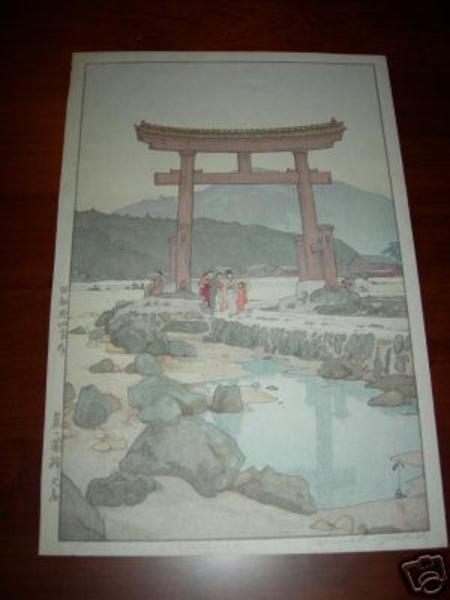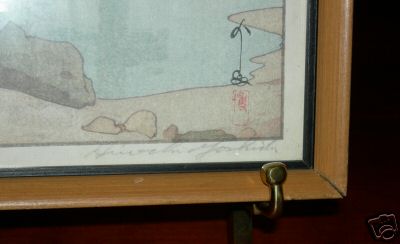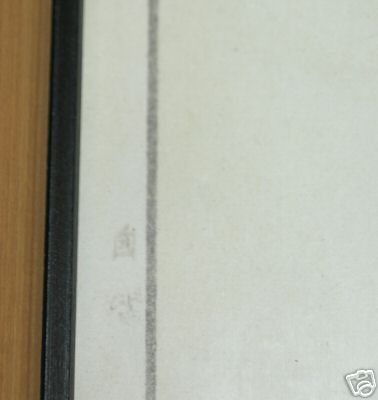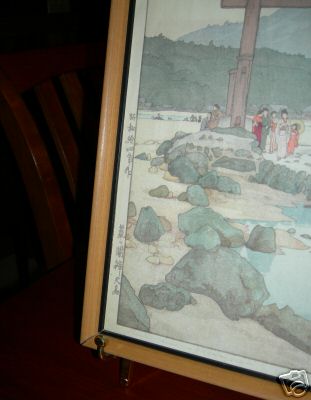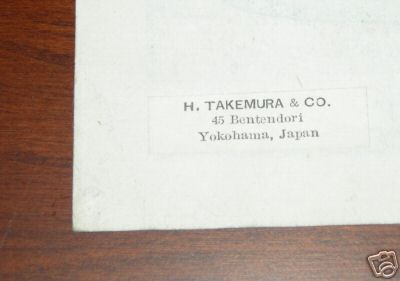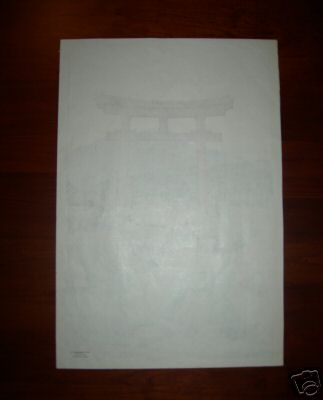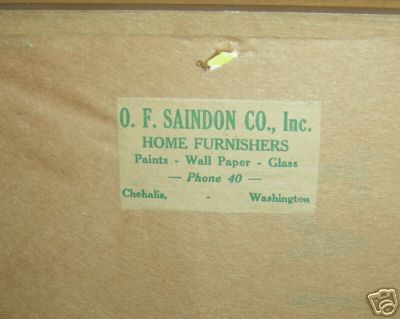| | |
| Artist: | Yoshida Hiroshi (1876-1950) — 吉田博 |
| Title: | Benten Shrine in Nezumigaseki Negumigaseki |
| Series: | |
| Date of first edition?: | Not set |
| Publisher (first edition)?: | Hiroshi Yoshida |
| Publisher (this edition)?: | Hiroshi Yoshida |
| Medium (first edition): | Woodblock |
| Medium (this edition): | Woodblock |
| Format (first edition): | Oban
|
| Format (this edition): | Oban |
| DB artwork code: | 40879 |
| Notes (first edition)?: |
|
| Notes (this edition)?: |
| The following information was taken from the original web listing of this artwork. Note that there may be some inaccuracies:
Sunday, 19 August 2007
A fine example of 20th-century printmaking by the Japanese master of the "shin hanga" movement, Hiroshi Yoshida. This woodblock, entitled "Benten Shrine in Nezumigaseki" [Nezugaseki], was first published by him in 1939 and depicts a group standing before a reflecting pool. A classic Yoshida image, as he was particularly known for his facility in depicting the subtleties of reflections and movement in water.
The signature "Yoshida" above the seal "Hiroshi" appears at the lower right corner of the image. The title and his pencil signature in English, characteristic of his prints which were destined for export to the Western world, are positioned respectively at the lower left and right corners of the bottom margin as shown. The significant brown jizuri or "self-printed" seal shows faintly at the upper left margin as I attempted to show in the attached photograph. The faintness of that seal and of the English title, as well as the subtle coloration of the image when compared with other published examples, leads me to believe that there may have been some fading to this print. Although I attempted to capture the color as accurately as possible, please note that the photos of the framed print are a few degrees darker than reality; the unframed image is a bit closer.
The frame, appropriately simple, light wood with a narrow black wood filet, bears an old label and original backing paper from a Chehalis, Washington establishment; given that the telephone number has only 2 digits, it appears that this was framed many years ago. I debated as to whether I should remove it from the frame, decided in the affirmative and was pleased to find that the print was not glued to the backing. There is a small label affixed to the lower left corner on the reverse, as shown: "H. Takemura & Co., 45 Bentendori, Yokohama, Japan". Some records I was able to trace dated his establishment as being active ca. 1926-1939. A old American advertising poster had been cut down to use as a cardboard stiffener within the frame and this is also illustrated. Fortunately, there is only a bit of minor darkening along the upper left side of the print. When seen in raking light, one can view a slight soft fold to the upper left corner, which I have tried to illustrate also, but this is not an impediment to the effect of the overall image and is difficult to discern under glass.
The overall measurement of the print with frame is approximately 11 1/2" w. x 16 5/8" h. Unframed, it is approximately 10 5/8" w. x 15 5/8" h. |
|
| Artist Bio: |
Yoshida Hiroshi (1876-1950)
This article is a review of the book The complete Woodblock Prints of Yoshida Hiroshi published by ABE Corporation, ISBN 4-87242-121-3.
Portrait of Yoshida Hiroshi
Yoshida Hiroshi is considered one of the leading figures of the renewal of Japanese printmaking after the end of the Meiji period (1912). The renewal was based on two groups of artists, the shin hanga (modern prints) and the sosaku hanga (creative prints) movement.
The Son of a School Principal
Yoshida Hiroshi was born as the son of an elementary school principal. His artistic talent was discovered early and at the age of 18 he entered a private art school in Tokyo.
Yoshida started as a painter and soon won many exibition prizes. But it was not before 1920 that he started creating woodblock prints. Yoshida Hiroshi then met Watanabe Shozaburo, publisher and owner of the Watanabe print store in Tokyo. Watanabe published the first seven of Yoshida Hiroshi's woodblock prints.
The Making of a Japanese Print
The Shalimar Gardens, 1932
The traditional process of creating a Japanese woodblock print was a cooperation of three strictly separated skills: the artist who designed the print subject, the carver and finally the printer and publisher. In contrast, the sosaku hanga followers believed that the process of creating a print - design, carving, printing - should be performed by the artist himself.
Although Yoshida is usally considered as a member of the shin hanga movement, he followed the same ambitions of creating a print by himself.
In 1923 Watanabe's store was completely destroyed in the fires that followed the great earthquake. All of Yoshida's woodblocks and more than a hundred of his prints were lost.
After coming back from his third visit to the United States, Yoshida in 1925 started employing his own artisan carvers and printers. He supervised them very closely and often he carved a block himself. He thought that he had to be more skilled in all aspects of producing a print than each of his workers.
Yoshida Hiroshi - an Avid Traveller
Kinoe, 1930
Yoshida travelled a lot. He came to the United States, Europe, Africa, India, China, Korea and througout Japan. Another passion was mountaineering. He even established an association called Nihon Sangakuga Kyokai, the Japan Alpine Artist Association. His prints reflect both his love for travelling and for mountains. Most of his prints show landscape scenes from his travels and mountain subjects from Japan and the European Alps.
Although his roots were in Japanese traditions, Yoshida was a real cosmopolitan artist who merged both worlds to something new and fascinating. When looking at his print scenes from abroad, you have the impression of being "on the spot". Yoshida is cited with the words "True art is cosmopolitan and the result therefore of external influences as well as of the inherent vitality and life of the different nations". Towards the end of his life, he planned a series entitled One Hundred Views of the World. Yoshida died before he could put his dream into reality.
At the end of his life, Yoshida Hiroshi had created 259 woodblock prints - seven published by Watanabe and the rest by Yoshida himself. It should not be forgotten that he gave the world even more than his own works of art: His both sons, Toshi and Hodaka Yoshida became great artists themselves.
The 1985 Commemorative Collection edition (西集記念)
From http://www.shogungallery.com/wwwboard/archive/oldmess/17.html :
In 1985, to celebrate a major exhibition of Hiroshi Yoshida's prints in Japan, Hiroshi's son, Toshi (an artist in his own right) published a number of his father's prints in commemoration, from the original blocks. These prints were of very high quality and according to Toshi limited to 300 impressions.
|
|


